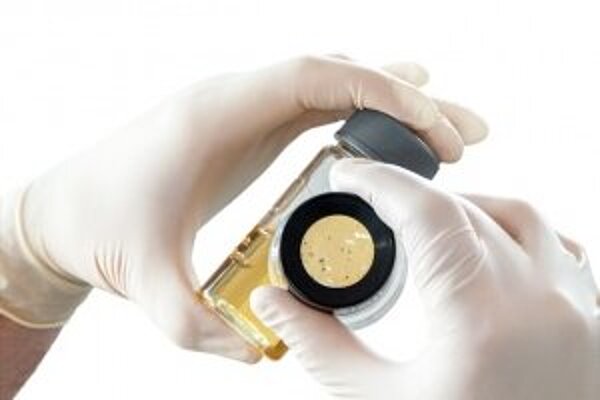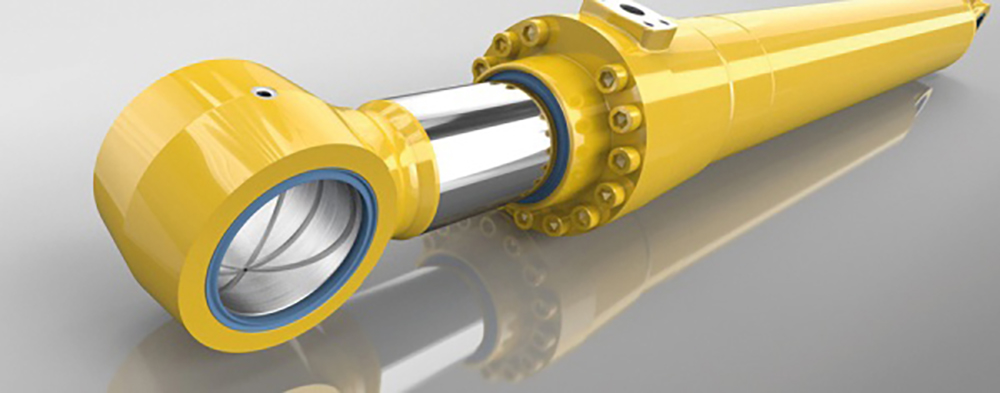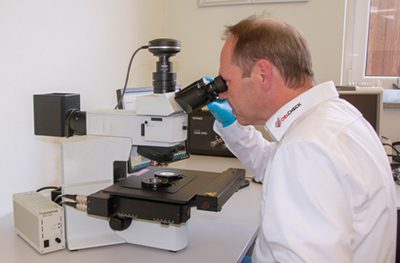Hydraulic fluids
Clean, bright and transparent – this is how most hydraulic fluids appear in the sample bottle. However, appearances can be deceiving! The human eye cannot detect fine contaminations smaller than 50 μm, and it is precisely these fi ne particles that can severely disrupt a hydraulic system. The particles are measured in μm, which is a millionth of a metre. Caution is already warranted if hydraulic fluid is contaminated with many particles from a size of 4 μm. The purity of fluids is a precondition for the safe operation of modern hydraulic systems. Selection, maintenance and regular monitoring of hydraulic fluids with laboratory analyses are becoming increasingly important.

Table of contents
A demanding double role
Hydraulic fluids concurrently function as a medium to the power transmission and as a lubricant. The enormous two-fold benefit provided by hydraulic fluids is often greatly underrated. The requirements placed on these fluids are constantly increasing as they must keep pace with the further technological development of hydraulic systems, which are becoming more and more powerful and compact. Smaller oil filling quantities lead to increased orbital speeds of oils and often also to higher operating temperatures and pressures. Gap tolerances decrease as pistons and valves have less manoeuvrability room. Concurrently, efficient and fault-free long-term usage of hydraulic systems over years has meanwhile become a matter of course. Yet this is only possible if the hydraulic fluids have the respective performance capacity and required degree of purity.
Purity is the key
Hydraulic fluids are construction elements for complex systems and not an arbitrarily exchangeable product, which is why they must be conscientiously selected, maintained and monitored. In addition to their viscosity, the degree of purity plays a decisive role from the very beginning. Hard but also soft contaminations in the hydraulic fluid are always a risk factor for systems. Depending on the application area, these contaminations cause most hydraulic malfunctions. Especially hard particles such as dust, metal abrasion or sealing materials as well as soft, adhesive parts from aged additive components, oxidation products and water put a strain on hydraulic fluids. Most often, the effect is severe: Particles cause wear in pumps, valves, motors, cylinders, gaskets and hoses. The control edges of valves can adhere and block valves. Filters clog up quicker and must be exchanged more frequently. Deposits in heat exchangers lead to higher operating temperatures and shorter oil life-cycles. Leaks can occur at valves, pumps, cylinders and motors. The effectiveness of hydraulics is also decreased.
Purity classes and contamination degrees
The size of particles in oil is measured in μm (millionth of a metre, micrometre). For illustration purposes: The human eye can easily see a hair, which has a diameter of approximately 75 μm, but can no longer detect objects of less than 50 μm. Specific analysis devices are used to detect fi ne contamination in oil samples. The contamination degree of oil depends on the number and size of contained particles. The more particles with a critical size are contained in the oil, the more likely resulting damage to components that come in contact with the oil. The degree of oil contamination is described by allocation to purity classes, which also provides a basis for comparison. The current ISO 4406:2017-08 describes the number of particles contained in 100 ml of oil. Organised according to size and quantity, the particles are subsequently cumulatively divided into specified particle ranges. ISO 4406:2017-08 provides a classification for particles with a size of ≥ 4 μm, ≥ 6 μm and ≥ 14 μm. The determined purity class of an oil is stated as a composite number, e.g. as 19/17/14.
DIN 51524 – not a measure of all things
DIN 51524 (2017) defines the minimum requirements for hydraulic oils in an unused condition with regard to water separation capacity, filter capacity, sealing compatibility, air separation capacity, oxidation stability and wear protection. Part 1 relates to DIN HL oils, part 2 to HLP oils and Part 3 to HVLP oils. As a minimum requirement, new oil must also adhere to the purity class 21/19/16. It has been taken into account that empty oil containers (primarily drums) are not exactly highly pure vessels prior to being filled with oil. While the minimum purity class 21/19/16 is e.g. sufficient for hydraulic oil for a robust lift, it does not usually fulfil the requirements for servo valves and many other applications. Principally the following applies: The more complex the system, the lower the gap tolerances and/or the greater the operating pressure and the higher the requirements for the purity of the hydraulic fluid. This is why many pump, valve and system manufacturers stipulate specific purity classes that are significantly narrower than the minimum requirements of the new DIN 51524 edition.
Purity analysis
Filters and sensors
When buying hydraulic oil, one should already check whether the product fulfils the purity class demanded by the system manufacturer. However, hydraulic fluid can also be contaminated during on-site storage and while filling it into the system. Absolute cleanliness is to be ensured during the process. Even when exercising extreme caution, filling via a special filter is always sensible. The purity of the oil may also be positively influenced during operation with additional and respectively designed partial-flow filters. For larger and/or sensitive hydraulic systems, it makes sense to permanently monitor the hydraulic fluid with a particle sensor. These sensors usually use light barriers to detect solid or dark particles in the oil fl ow. The alarm sounds if specified limits are exceeded. Combination devices are also often used that additionally monitor the water content. The following must be clarified before installing the sensors:
- Degree of measurement precision
- Optimal sensor position
- Type of data transfer
- Response to exceeding limit values
Each oil sensor must be calibrated. Evaluation electronics use reference values that are specified for a certain oil and sensor. Particle monitors with online signals can substantially contribute to the operational safety of hydraulic systems. However, the precondition for this is that the oil type is not changed and the oil is not contaminated with ageing products and/or too much moisture. Too much moisture makes the oil opaque, which can make it difficult for the sensor to properly detect particles. The sensor also has difficulties if oils are mixed and maybe even incompatible with each other. Principally, a particle monitor provides the latest measurement values with regard to the number of particles. However, it does not detect whether external contamination (dust), wear or degraded EP additives or VI improvers are the cause.
OELCHECK laboratory analyses for maximum security
Although online oil sensors immediately detect possible critical operating conditions, a qualified oil analysis in the laboratory is indispensable. The variety of exact measurement values provides an overall image and thus a decisive basis for assessing the oil condition. The counting of particles with the indication of the purity class is part of all all-inclusive analysis kits for hydraulic fluids that are recommended by tribologists. Laboratory analyses of hydraulic oils are an important control instrument for the following:
- Examining new products prior to filling these into the system
- Assistance with the search for possible errors or causes of damage if an oil sensor sounds an alarm
- Determination of condition-dependent oil change intervals
- Optimisation of fluid management Trends can be recognised based on regular lubrication analyses, which can extend the service life of oil and allow for better maintenance planning. Trend analyses sustainably contribute to increasing the operational safety and efficiency of the total system.
Informative samples
Instructions for sampling are available in the download area at oelcheck.de for proper on-site oil extraction and to ensure that the analysis provides representative results. Many system manufacturers have also published precise specifications for sampling. Principally, extraction valves/miniature measuring connections should be rinsed with a rinsing device when sampling with these. Extraction from the middle of the filling level is ideal when sampling from a tank. The various trend analyses that we perform for the hydraulic oils of our customers demonstrate how consistently they follow these recommendations. The oil samples are almost always representative. Usually, larger value deviations only occur if the fluid is contaminated.
Particle counting – standardized and checked three times
The OELCHECK laboratory is equipped with multiple state-of-the-art analysis devices due to the large number of samples that are to be analysed on a daily basis. Various devices are available for counting particles. OELCHECK examines the majority of hydraulic oil samples with a laser particle counter. This counter type is also used for determining particle quantities in turbine oils, oils from compactors and compressors and even transmission oils with high viscosity. The particles determined in hydraulic fluids are categorized according to the size classes ≥ 4 μm, ≥ 6 μm and ≥ 14 μm, and the purity class of the oil is determined according to ISO 4406:2017. The analysis is exactly performed according to the specifications of ISO 11500 and ASTM D7647 in order to ensure a high precision. This also includes the careful preparation of each sample. Thereby, irregularities that can certainly occur during the analysis with an online sensor are excluded.
In the OELCHECK laboratory, 20 ml of oil from the sample are mixed with a solvent in a ratio of 2:1 so that the particles can be optimally identified with the laser sensor. The mixture is homogenized and degassed just prior to the measurement. Air bubbles escape quickly from the diluted sample and are therefore not counted during the analysis. The solvent contained in the sample causes the dissolution and “disappearance” of water drops. The solvent also dissolves existing soft reaction and oil-ageing products and thereby ensures that only the hard particles contained in the oil or soot particles from the diesel effect are counted. Three consecutive counts are performed with a total volume of approx. 30 ml from which a medium value is then determined. The particle counter discards the entire analysis if the individual values greatly vary from each other. Particle counting does not closely examine water drops or oil-ageing products. Test methods such as the Karl Fischer test, the determination of the acid number or infrared spectroscopy are used for this. The MPC test provides information about the danger of deposits such as from possible oil-ageing products and/or unusual additives.
Extras in the OELCHECK laboratory report:
- In addition to the classic particle sizes ≥ 4 μm, ≥ 6 μm and ≥ 14 μm, we also state the number of particles ≥ 21, ≥ 38 and ≥ 70.
- We also determine the less common purity class SAE AS 4059, which is nonetheless highly relevant for some customers The Society of Automotive Engineers defined the class as AS (Aerospace Standard).
![[Translate to "English"] Hydraulikfluids](/fileadmin/user_upload/img/wiki-pics/Hydraulikfluids_Iso4406.jpg)
![[Translate to "English"] Mindestanforderung für Frischöl [Translate to "English"] Mindestanforderung für Frischöl](/fileadmin/user_upload/img/wiki-pics/Hydraulikfluids_PCOS3418840_003.jpg)
![[Translate to "English"] Empfohlene Reinheitsklasse für moderne Servohydraulik [Translate to "English"] Empfohlene Reinheitsklasse für moderne Servohydraulik](/fileadmin/user_upload/img/wiki-pics/Hydraulikfluids_PCOS8079509_002.jpg)
Particle counting for aqueous, opaque and dark fluids
Water drops should not be included in the particle count. Yet, what about low-flammable hydraulic fluids of the classes HFA to HFC with a high water content? Using laser particle counters does not make sense for these. OELCHECK examines these and other opaque (milky) or dark or excessively contaminated fluids with an Olympus BX51 microscope. For this purpose, the homogenised sample is filtered through a filter membrane with a pore width of 1.2 μm. The membrane is dried after rinsing with solvent. A representative surface of the membrane is microscopically “scanned” in the reflected light mode. All particles that appear darker in the grey level of the membrane are photographed with a high-resolution CCD camera, measured with image analysis software and categorized based on the longest expansion. The categorisation into the size classes ≥ 5 μm and ≥15 μm is specified for microscopic particle counting while ISO 4406:2017 envisages the categorisation into the size classes ≥ 4 μm, ≥ 6 μm and ≥ 14 μm for laser particle counting. The OELCHECK laboratory performs the microscopic particle count according to the stipulations of ISO 4407, which allows for a determination of particles in the size classes ≥ 2 μm, ≥ 5 μm, ≥ 15 μm, ≥ 25 μm, ≥ 50 μm and ≥ 100 μm.
Extras in the OELCHECK laboratory report:
- For particle counting with the microscope, OELCHECK specifies more differentiated size classes than stated in ISO 4407. The following classes are listed in the laboratory report: ≥ 2 μm, ≥ 5 μm, ≥ 10 μm ≥ 15 μm, ≥ 25 μm, ≥ 50 μm, ≥ 100 μm, ≥ 150 μm, ≥ 250 μm and ≥ 500 μm.
The Olympus BX51 microscope delivers these additional values with its fi rst-rate software.
- The laboratory report also depicts a representative photo of the test membrane and the largest detected particle. The analysis results are also visually elucidated with the microscope.
The particle count in the OELCHECK laboratory is performed with maximum precision. We are nonetheless still actively involved in research projects that deal with the optimisation and further development of particle counting techniques, specifically in the online method by means of sensors.









